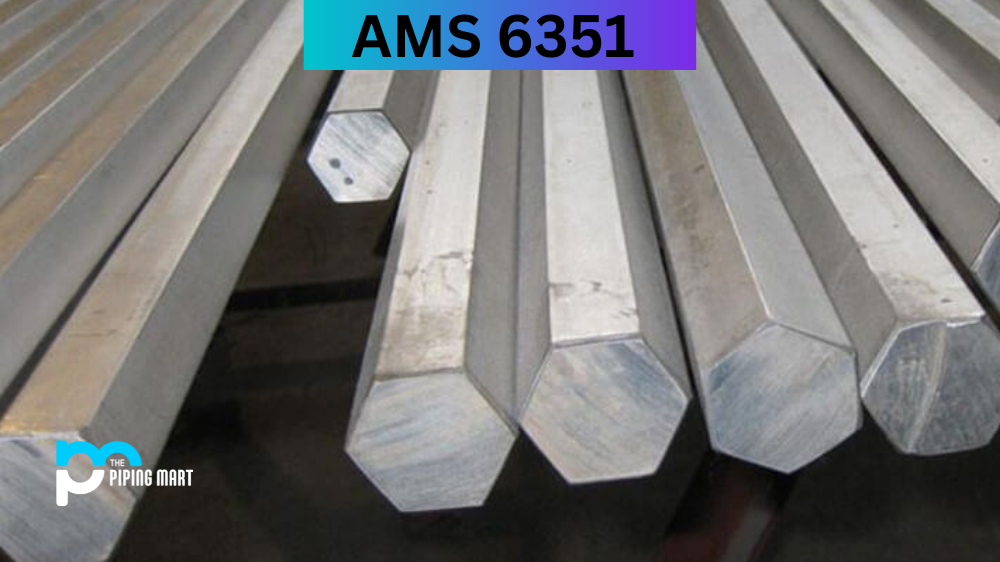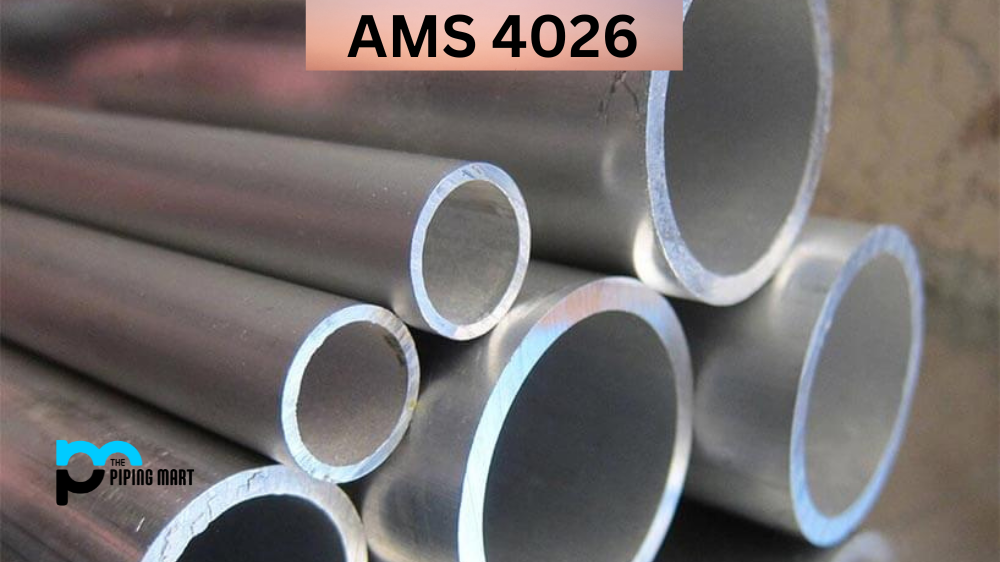If you are in the aerospace, automotive or defence industry, you have likely come across AMS6351. This high-strength low-alloy steel has gained popularity over the years for its unique properties. Whether you are considering using it for your project or are just curious to know more, this article will provide all the information you need about AMS 6351.
What is AMS 6351?
AMS 6351 (also known as AISI 4130 Alloy Steel) is a specification governing the production of seamless steel tubing for use in aircraft systems. This specification outlines the requirements for the chemical composition, mechanical properties, and heat treatment of the steel used in the manufacturing process. The resulting tubing is designed to be strong, durable, and able to withstand the extreme conditions that aircraft may encounter during flight. As we rely on air transportation more daily, it’s amazing to think about the precision and attention to detail that goes into the parts that keep us in the sky. Applying AMS6351 is crucial to ensure these parts are up for the challenge.
What Form is AMS 6351 Available at Piping Mart?
- Alloy Steel AISI 4130 Bars
AMS 6351 Composition
AMS6351 is a type of steel that falls under the AMS specifications. AMS is an abbreviation for “Aerospace Material Specifications”, which refers to standards developed and published by SAE International, a global organization that sets standards for various industries. This type of steel comprises elements such as carbon, manganese, silicon, nickel, chromium, and molybdenum. The composition of AMS 6351 varies based on the manufacturer, but it typically contains about 0.38% carbon, 0.70-1.00% manganese, 0.15-0.35% silicon, 0.40-0.70% nickel, 0.80-1.10% chromium, and 0.15-0.25% molybdenum.
| Element | Content (%) |
|---|---|
| Iron, Fe | 97.03 – 98.22 |
| Chromium, Cr | 0.80 – 1.10 |
| Manganese, Mn | 0.40 – 0.60 |
| Carbon, C | 0.280 – 0.330 |
| Silicon, Si | 0.15 – 0.30 |
| Molybdenum, Mo | 0.15 – 0.25 |
| Sulfur, S | 0.040 |
| Phosphorous, P | 0.035 |
AMS 6351 Physical properties
AMS 6351 has unique physical properties that make it stand out from other types of steel. It is low-alloy steel, which means it has low carbon content and is highly durable, making it ideal for parts that require high strength and toughness. It is also highly resistant to corrosion, which is crucial in applications such as aircraft and defence equipment. AMS 6351 also has a high fatigue strength, making it ideal for applications requiring parts to withstand constant loading and unloading cycles.
| Properties | Metric | Imperial |
|---|---|---|
| Density | 7.85 g/cm3 | 0.284 lb/in³ |
| Melting point | 1432°C | 2610°F |
AMS 6351 Mechanical properties
Regarding mechanical properties, AMS 6351 is known for its exceptional strength-to-weight ratio. It has a high tensile strength of up to 185 ksi (kilo pounds per square inch) and a yield strength of up to 150 ksi, making it ideal for high-stress applications. Its flexibility and toughness also make it ideal for parts that require heavy machining, such as gears and shafts.
| Properties | Metric | Imperial |
|---|---|---|
| Tensile strength, ultimate | 560 MPa | 81200 psi |
| Tensile strength, yield | 460 MPa | 66700 psi |
| Modulus of elasticity | 190-210 GPa | 27557-30458 ksi |
| Bulk modulus (Typical for steel) | 140 GPa | 20300 ksi |
| Shear modulus (Typical for steel) | 80 GPa | 11600 ksi |
| Poissons ratio | 0.27-0.30 | 0.27-0.30 |
| Elongation at break (in 50 mm) | 21.50% | 21.50% |
| Reduction of area | 59.6 | 59.60% |
| Hardness, Brinell | 217 | 217 |
| Hardness, Knoop (Converted from Brinell hardness) | 240 | 240 |
| Hardness, Rockwell B (Converted from Brinell hardness) | 95 | 95 |
| Hardness, Rockwell C (Converted from Brinell hardness, value below normal HRC range, for comparison purposes only.) | 17 | 17 |
| Hardness, Vickers (Converted from Brinell hardness) | 228 | 228 |
| Machinability (Annealed and cold drawn. Based on 100% machinability for AISI 1212 steel.) | 70 | 70 |
AMS 6351 Equivalents
| AMS 6348 | AMS 6371 | ASTM A331 | ASTM A829 | DIN 1.7218 |
| AMS 6350 | AMS 6373 | ASTM A506 | MIL S-18729 | UNI 25 CrMo 4 |
| AMS 6351 | AMS 6374 | ASTM A507 | MIL S-6758 | JIS SCCrM 1 |
| AMS 6360 | AMS 6528 | ASTM A513 | SAE J1397 | JIS SCM 2 |
| AMS 6361 | AMS 7496 | ASTM A519 | SAE J404 | SS 2225 |
| AMS 6362 | ASTM A29 | ASTM A646 | SAE J412 | B.S. CDS 110 |
| AMS 6370 | ASTM A322 | ASTM A752 | AFNOR 25 CD 4 (S) | SAE J770 |
AMS 6351 Uses
AMS 6351 finds use in various applications, from aircraft and missile components to racing car engines and critical defence equipment. Its unique physical and mechanical properties combination means it can be used in parts requiring high wear resistance, corrosion, and fatigue. It is also highly machinable and can be easily welded, making it an ideal choice for parts that need complex shapes and designs.
AMS 6351 Hardness
Regarding hardness, AMS 6351 can be hardened to various Rockwell scales depending on the heat treatment used. The two primary methods for heat treatment are austenitizing followed by oil or water quenching or annealing, which is a slow cooling process. AMS 6351 is typically hardened to a Rockwell hardness between 35 and 60.
AMS 6351 Heat Treatment
Heat treatment is a crucial part of the manufacturing process for many materials. The heat treatment process can increase a material’s strength, hardness, and durability by altering its microstructure. AMS 6351 is a specific type of steel commonly used in the aerospace industry due to its strength and toughness. This makes AMS 6351 an ideal candidate for heat treatment. By carefully controlling the heating and cooling process, manufacturers can optimize the material’s properties to suit their needs. Understanding the intricacies of heat treatment and its effects on different materials is necessary for any manufacturer looking to create top-quality products.
Conclusion:
AMS 6351 material is a unique type of steel with a wide range of applications due to its unique physical and mechanical properties. Its low alloy composition and exceptional strength-to-weight ratio make it ideal for high-stress applications requiring parts to withstand constant loading and unloading cycles. Its wear, corrosion, and fatigue resistance means it can be used in critical defence equipment, aircraft and missile components, and racing car engines. Knowing the composition, physical and mechanical properties, hardness, and heat treatment methods for AMS 6351 are crucial in determining whether it is the right type of steel for your project.

A passionate metal industry expert and blogger. With over 5 years of experience in the field, Palak brings a wealth of knowledge and insight to her writing. Whether discussing the latest trends in the metal industry or sharing tips, she is dedicated to helping others succeed in the metal industry.




